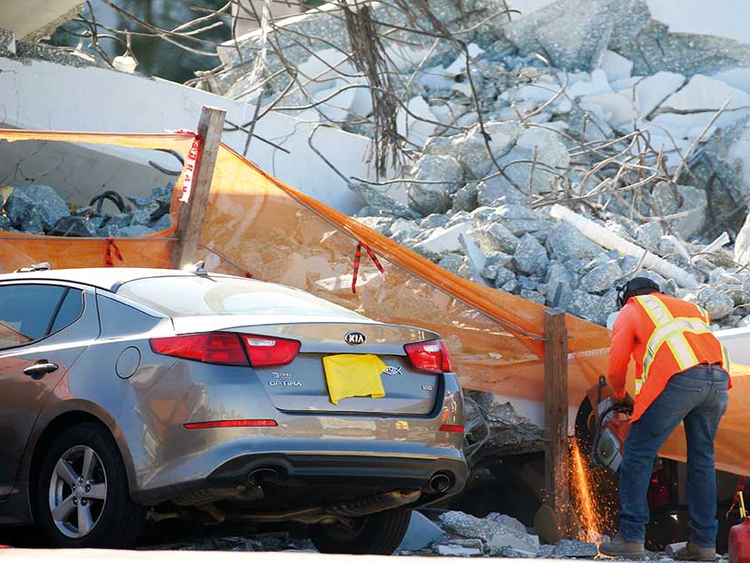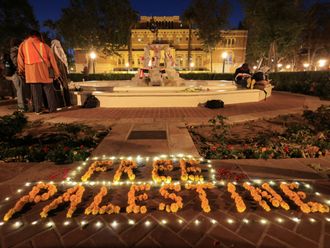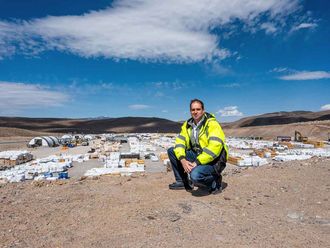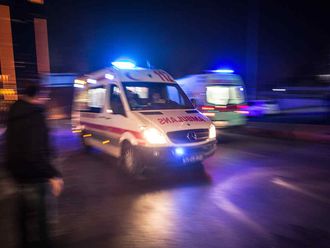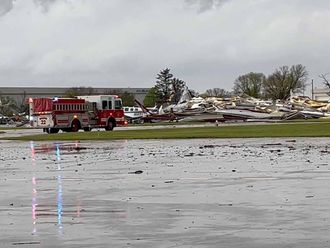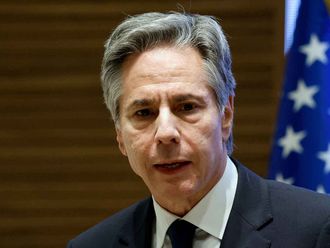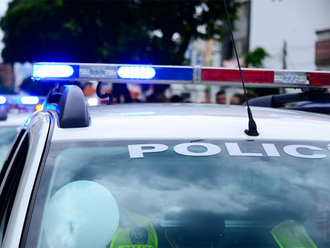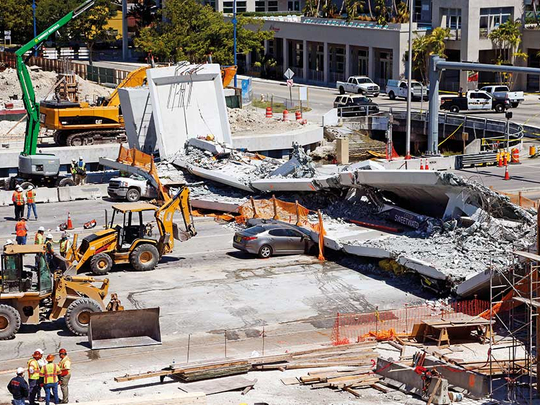
MIAMI: An engineer reported cracks on a newly installed pedestrian bridge two days before it collapsed on a busy roadway here, killing at least six people, state officials said on Friday.
The report, by the lead engineer with the company in charge of the bridge’s design, was made in a voicemail message left for a Florida Department of Transportation employee.
That employee was out of the office, however, and did not receive it until Friday, a day after the collapse.
The cracking was on the north end of the span but the company did not consider it a safety concern, according to a recording of the message released by the Transportation Department.
“We’ve taken a look at it and, uh, obviously some repairs or whatever will have to be done, but from a safety perspective we don’t see that there’s any issue there so we’re not concerned about it from that perspective,” said the engineer, W. Denney Pate.
“Although obviously the cracking is not good and something’s going to have to be, you know, done to repair that.”
"The transportation department said on Friday that “the responsibility to identify and address life-safety issues and properly communicate them is the sole responsibility of the FIU design-build team,” referring to Florida International University, which commissioned the bridge.
In a statement, Figg Bridge Engineers said that it was “heart-broken by the loss of life and injuries” and that it was carefully examining the steps that its team had taken “in the interest of our overarching concern for public safety.”
“The evaluation was based on the best available information at that time and indicated that there were no safety issues,” the statement said.
"“It is important that the agencies responsible for investigating this devastating situation are given the appropriate time in order to accurately identify what factors led to the accident during construction.”
Engineering failure
Earlier Friday, the authorities in Miami-Dade County announced that they had called off the search for survivors.
Officials were turning their attention to finding out exactly why the new bridge — hailed as a breakthrough in speedy, safe construction — had given way over the road beneath, killing at least half a dozen people and sending 10 more to hospitals.
As a backhoe slowly lifted the rubble off cars, some of them with bodies still inside, investigators said they were only beginning to consider possible failures of engineering, construction and traffic planning.
What role, if any, that cracks played in the collapse has yet to be determined.
“A crack in a bridge does not necessarily mean it’s unsafe,” said Robert Accetta, an official of the National Transportation Safety Board, which is investigating the accident, said at a news conference Friday night. The NTSB chairman, Robert Sumwalt, said the board had not yet determined on its own if there were cracks.
Construction crews were tightening cables on the bridge when it fell, the NTSB said, which is not unusual after installation.
Accetta said the safety board would look at whether that process contributed to the collapse, adding that the “point of failure” was still unclear.
Voicemail
But the possibility that cracks had occurred and had been communicated only via voicemail was sure to become a focus of scrutiny and of finger-pointing.
Two days after the voicemail message was left, and one day before it was heard, the Florida Department of Transportation said, one of its consultants took part in a meeting with the bridge’s design and construction team.
At the meeting the state consultant “was not notified of any life-safety issues, need for additional road closures or requests for any other assistance from FDOT,” the department said.
The meeting took place at noon Thursday. At around 1:30pm, the bridge collapsed.
“At no point during any of the communications above did Figg or any member of the FIU design-build team ever communicate a life-safety issue,” the state Transportation Department said in its statement.
Another major question is whether Southwest Eighth Street, the busy thoroughfare below the walkway, should have been open when the walkway was undergoing crucial adjustments.
The state transportation agency said it had received no requests to close the road.
None of the victims had been officially identified on Friday night, possibly because their bodies were still buried in their cars. But family members of several missing people feared the worst.
Alexa Duran and her friend, Richard Humble, both FIU students, had been stopped in a Toyota 4Runner under the bridge because of a red light ahead.
The concrete overhead creaked. Humble looked up and saw the structure falling. It crushed the car and squashed his neck, trapping him inside.
'I thought...I was dead'
“I thought when I saw the bridge coming down that I was dead,” he told NBC News.
Passers-by freed him.
But Duran, a freshman who lived at home and was close with her parents, often pressing shirts at the family’s dry cleaning business, did not make it out.
The $14 million walkway, which was to carry FIU students and other pedestrians over Southwest Eighth Street, was built using “accelerated construction,” a well-regarded method of erecting bridges that avoids the long months of street closings when a structure is built over a road or river. Instead, parts of the bridge are prefabricated away from the site and then moved into place.
Bridges made using the accelerated techniques are not more at risk of collapse than others, but moving them into place causes different stresses than what the bridge would normally have to withstand, said Andy Herrmann, a former president of the American Society of Civil Engineers.
Accetta said that the NTSB had not previously had to investigate an accident involving this kind of bridge.
“This is a different design type of bridge,” he said. “It’s not something that we’ve encountered before.”


